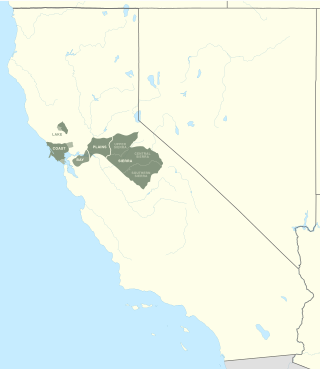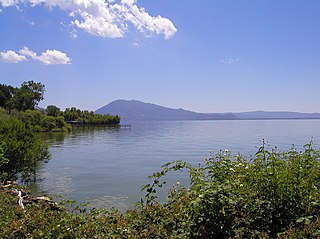Related Research Articles

The Rumsen language is one of eight Ohlone languages, historically spoken by the Rumsen people of Northern California. The Rumsen language was spoken from the Pajaro River to Point Sur, and on the lower courses of the Pajaro, as well as on the Salinas and Carmel Rivers, and the region of the present-day cities of Salinas, Monterey and Carmel.

The Miwok are members of four linguistically related Native American groups Indigenous to what is now Northern California, who traditionally spoke one of the Miwok languages in the Utian family. The word Miwok means people in the Miwok languages.

The Coast Miwok are an Indigenous people of California that were the second-largest tribe of the Miwok people. Coast Miwok inhabited the general area of modern Marin County and southern Sonoma County in Northern California, from the Golden Gate north to Duncans Point and eastward to Sonoma Creek. Coast Miwok included the Bodega Bay Miwok, or Olamentko (Olamentke), from authenticated Miwok villages around Bodega Bay, the Marin Miwok, or Hookooeko (Huukuiko), and Southern Sonoma Miwok, or Lekahtewutko (Lekatuit). While they did not have an overarching name for themselves, the Coast Miwok word for people, Micha-ko, was suggested by A. L. Kroeber as a possible endonym, keeping with a common practice among tribal groups and the ethnographers studying them in the early 20th Century and with the term Miwok itself, which is the Central Sierra Miwok word for people.
The Bay Miwok are a cultural and linguistic group of Miwok, a Native American people in Northern California who live in Contra Costa County. They joined the Franciscan mission system during the early nineteenth century, suffered a devastating population decline, and lost their language as they intermarried with other native California ethnic groups and learned the Spanish language.

Penutian is a proposed grouping of language families that includes many Native American languages of western North America, predominantly spoken at one time in British Columbia, Washington, Oregon, and California. The existence of a Penutian stock or phylum has been the subject of debate among specialists. Even the unity of some of its component families has been disputed. Some of the problems in the comparative study of languages within the phylum are the result of their early extinction and limited documentation.

Yokuts, formerly known as Mariposa, is an endangered language family spoken in the interior of Northern and Central California in and around the San Joaquin Valley by the Yokuts people. The speakers of Yokuts languages were severely affected by disease, missionaries, and the Gold Rush. While descendants of Yokuts speakers currently number in the thousands, all languages apart from Valley Yokuts are now extinct.

Utian is a family of Indigenous languages spoken in Northern California, United States. The Miwok and Ohlone peoples both spoke languages of the Utian language family. It has recently been argued that the Utian languages and Yokuts languages are sub-families of the Yok-Utian language family. Utian and Yokutsan have traditionally been considered part of the Penutian language phylum.

The Miwok or Miwokan languages, also known as Moquelumnan or Miwuk, are a group of endangered languages spoken in central California by the Miwok peoples, ranging from the Bay Area to the Sierra Nevada. There are seven Miwok languages, four of which have distinct regional dialects. There are a few dozen speakers of the three Sierra Miwok languages, and in 1994 there were two speakers of Lake Miwok. The best attested language is Southern Sierra Miwok, from which the name Yosemite originates. The name Miwok comes from the Northern Sierra Miwok word miw·yk meaning 'people.'

Mono is a Native American language of the Numic group of Uto-Aztecan languages, the ancestral language of the Mono people. Mono consists of two dialects, Eastern and Western. The name "Monachi" is commonly used in reference to Western Mono and "Owens Valley Paiute" in reference to Eastern Mono. In 1925, Alfred Kroeber estimated that Mono had 3,000 to 4,000 speakers. As of 1994, only 37 elderly people spoke Mono as their first language. It is classified as critically endangered by UNESCO. It is spoken in the southern Sierra Nevada, the Mono Basin, and the Owens Valley of central-eastern California. Mono is most closely related to Northern Paiute; these two are classified as the Western group of the Numic branch of the Uto-Aztecan language family.

Yok-Utian is a proposed language family of California. It consists of the Yokuts language and the Utian language family.

The Lake Miwok are a branch of the Miwok, a Native American people of Northern California. The Lake Miwok lived in the Clear Lake basin of what is now called Lake County. While they did not have an overarching name for themselves, the Lake Miwok word for people, Hotsa-ho, was suggested by A. L. Kroeber as a possible endonym, keeping with a common practice among tribal groups and the ethnographers studying them in the early 20th Century and with the term Miwok itself, which is the Central Sierra Miwok word for people.

The Plains and Sierra Miwok were once the largest group of California Indian Miwok people, Indigenous to California. Their homeland included regions of the Sacramento Valley, San Joaquin Valley, and the Sierra Nevada.
Southern Sierra Miwok is a Utian language spoken by the Native American people called the Southern Sierra Miwok of Northern California. Southern Sierra Miwok is a member of the Miwok language family. The Miwok languages are a part of the larger Utian family. The original territory of the Southern Sierra Miwok people is similar to modern day Mariposa County, California. The Southern Sierra Miwok language is nearly extinct with only a few speakers existing today. However, as of 2012, an active revitalization program is underway.
Lake Miwok traditional narratives include myths, legends, tales, and oral histories preserved by the Lake Miwok people of Clear Lake in the North Coast Range of northwestern California.
Plains Miwok, also known as Valley Miwok, was one of the Miwok languages spoken in central California by the Plains Miwok people. It was spoken in the deltas of the San Joaquin and Cosumnes Rivers. Plains Miwok was once one of the most populous Miwok languages. All of the population has shifted to English.
The Lake Miwok language is an extinct language of Northern California, traditionally spoken in an area adjacent to the Clear Lake. It is one of the languages of the Clear Lake Linguistic Area, along with Patwin, East and Southeastern Pomo, and Wappo.

The Ohlone languages, also known as Costanoan, form a small Indigenous language family historically spoken in Northern California, both in the southern San Francisco Bay Area and northern Monterey Bay area, by the Ohlone people. Along with the Miwok languages, they are members of the Utian language family. The most recent work suggests that Ohlone, Miwok, and Yokuts are branches of a Yok-Utian language family.
Coast Miwok was one of the Miwok languages spoken in California, from San Francisco Bay to Bodega Bay. The Marin and Bodega varieties may have been separate languages. All of the population has shifted to English.
Sylvia Marguerite Broadbent was an American anthropologist and professor, specializing in Amerindian peoples.
Catherine "Cathy" Callaghan was Professor Emerita in the Department of Linguistics at the Ohio State University in Columbus, Ohio.
References
- 1 2 Northern Sierra Miwok at Ethnologue (25th ed., 2022)

- 1 2 Callaghan, Catherine A. (1987). Northern Sierra Miwok Dictionary, Volumes 109-110. University of California Press. ISBN 9780520097124.
- Callaghan, Catherine A. 1987. Northern Sierra Miwok dictionary. Berkeley: University of California Press.
- Freeland, L. S. 1951. Language of the Sierra Miwok. (Publications in Anthropology and Linguistics, Memoir 6.) Bloomington, IN: Indiana University Press.
- Golla, Victor. 2011. California Indian languages. Berkeley: University of California Press.
- Northern Miwok Indians. "Rodriguez-Nieto Guide" Sound Recordings (California Indian Library Collections), LA007, LA140. Berkeley: California Indian Library Collections, 1993. "Sound recordings reproduced from the Language Archive sound recordings at the Language Laboratory, University of California, Berkeley".